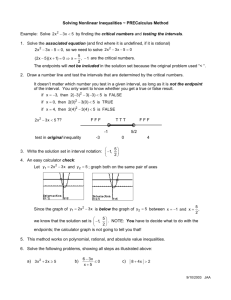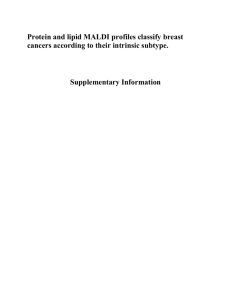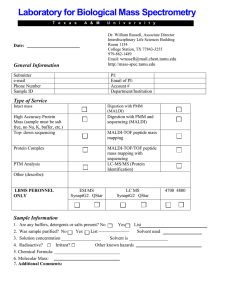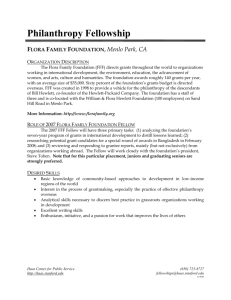Analysis of Whole Bacterial Cells by Flow Desorption/Ionization Time-of-Flight Mass
advertisement
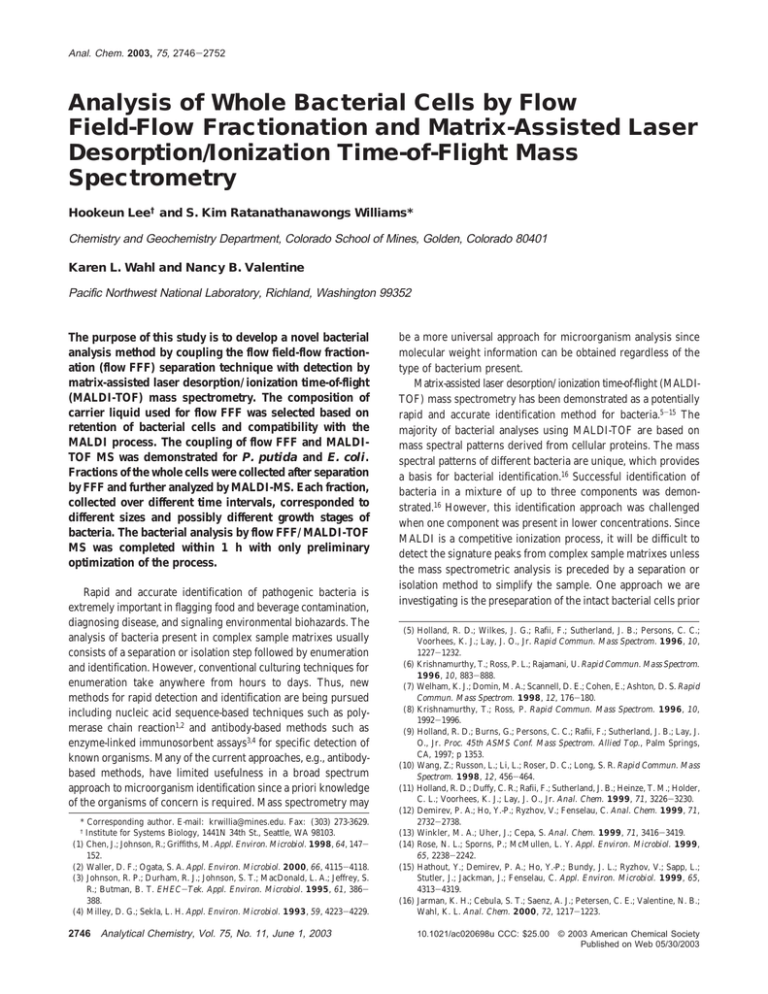
Anal. Chem. 2003, 75, 2746-2752 Analysis of Whole Bacterial Cells by Flow Field-Flow Fractionation and Matrix-Assisted Laser Desorption/Ionization Time-of-Flight Mass Spectrometry Hookeun Lee† and S. Kim Ratanathanawongs Williams* Chemistry and Geochemistry Department, Colorado School of Mines, Golden, Colorado 80401 Karen L. Wahl and Nancy B. Valentine Pacific Northwest National Laboratory, Richland, Washington 99352 The purpose of this study is to develop a novel bacterial analysis method by coupling the flow field-flow fractionation (flow FFF) separation technique with detection by matrix-assisted laser desorption/ionization time-of-flight (MALDI-TOF) mass spectrometry. The composition of carrier liquid used for flow FFF was selected based on retention of bacterial cells and compatibility with the MALDI process. The coupling of flow FFF and MALDITOF MS was demonstrated for P. putida and E. coli. Fractions of the whole cells were collected after separation by FFF and further analyzed by MALDI-MS. Each fraction, collected over different time intervals, corresponded to different sizes and possibly different growth stages of bacteria. The bacterial analysis by flow FFF/MALDI-TOF MS was completed within 1 h with only preliminary optimization of the process. Rapid and accurate identification of pathogenic bacteria is extremely important in flagging food and beverage contamination, diagnosing disease, and signaling environmental biohazards. The analysis of bacteria present in complex sample matrixes usually consists of a separation or isolation step followed by enumeration and identification. However, conventional culturing techniques for enumeration take anywhere from hours to days. Thus, new methods for rapid detection and identification are being pursued including nucleic acid sequence-based techniques such as polymerase chain reaction1,2 and antibody-based methods such as enzyme-linked immunosorbent assays3,4 for specific detection of known organisms. Many of the current approaches, e.g., antibodybased methods, have limited usefulness in a broad spectrum approach to microorganism identification since a priori knowledge of the organisms of concern is required. Mass spectrometry may * Corresponding author. E-mail: krwillia@mines.edu. Fax: (303) 273-3629. † Institute for Systems Biology, 1441N 34th St., Seattle, WA 98103. (1) Chen, J.; Johnson, R.; Griffiths, M. Appl. Environ. Microbiol. 1998, 64, 147152. (2) Waller, D. F.; Ogata, S. A. Appl. Environ. Microbiol. 2000, 66, 4115-4118. (3) Johnson, R. P.; Durham, R. J.; Johnson, S. T.; MacDonald, L. A.; Jeffrey, S. R.; Butman, B. T. EHEC-Tek. Appl. Environ. Microbiol. 1995, 61, 386388. (4) Milley, D. G.; Sekla, L. H. Appl. Environ. Microbiol. 1993, 59, 4223-4229. 2746 Analytical Chemistry, Vol. 75, No. 11, June 1, 2003 be a more universal approach for microorganism analysis since molecular weight information can be obtained regardless of the type of bacterium present. Matrix-assisted laser desorption/ionization time-of-flight (MALDITOF) mass spectrometry has been demonstrated as a potentially rapid and accurate identification method for bacteria.5-15 The majority of bacterial analyses using MALDI-TOF are based on mass spectral patterns derived from cellular proteins. The mass spectral patterns of different bacteria are unique, which provides a basis for bacterial identification.16 Successful identification of bacteria in a mixture of up to three components was demonstrated.16 However, this identification approach was challenged when one component was present in lower concentrations. Since MALDI is a competitive ionization process, it will be difficult to detect the signature peaks from complex sample matrixes unless the mass spectrometric analysis is preceded by a separation or isolation method to simplify the sample. One approach we are investigating is the preseparation of the intact bacterial cells prior (5) Holland, R. D.; Wilkes, J. G.; Rafii, F.; Sutherland, J. B.; Persons, C. C.; Voorhees, K. J.; Lay, J. O., Jr. Rapid Commun. Mass Spectrom. 1996, 10, 1227-1232. (6) Krishnamurthy, T.; Ross, P. L.; Rajamani, U. Rapid Commun. Mass Spectrom. 1996, 10, 883-888. (7) Welham, K. J.; Domin, M. A.; Scannell, D. E.; Cohen, E.; Ashton, D. S. Rapid Commun. Mass Spectrom. 1998, 12, 176-180. (8) Krishnamurthy, T.; Ross, P. Rapid Commun. Mass Spectrom. 1996, 10, 1992-1996. (9) Holland, R. D.; Burns, G.; Persons, C. C.; Rafii, F.; Sutherland, J. B.; Lay, J. O., Jr. Proc. 45th ASMS Conf. Mass Spectrom. Allied Top., Palm Springs, CA, 1997; p 1353. (10) Wang, Z.; Russon, L.; Li, L.; Roser, D. C.; Long, S. R. Rapid Commun. Mass Spectrom. 1998, 12, 456-464. (11) Holland, R. D.; Duffy, C. R.; Rafii, F.; Sutherland, J. B.; Heinze, T. M.; Holder, C. L.; Voorhees, K. J.; Lay, J. O., Jr. Anal. Chem. 1999, 71, 3226-3230. (12) Demirev, P. A.; Ho, Y.-P.; Ryzhov, V.; Fenselau, C. Anal. Chem. 1999, 71, 2732-2738. (13) Winkler, M. A.; Uher, J.; Cepa, S. Anal. Chem. 1999, 71, 3416-3419. (14) Rose, N. L.; Sporns, P.; McMullen, L. Y. Appl. Environ. Microbiol. 1999, 65, 2238-2242. (15) Hathout, Y.; Demirev, P. A.; Ho, Y.-P.; Bundy, J. L.; Ryzhov, V.; Sapp, L.; Stutler, J.; Jackman, J.; Fenselau, C. Appl. Environ. Microbiol. 1999, 65, 4313-4319. (16) Jarman, K. H.; Cebula, S. T.; Saenz, A. J.; Petersen, C. E.; Valentine, N. B.; Wahl, K. L. Anal. Chem. 2000, 72, 1217-1223. 10.1021/ac020698u CCC: $25.00 © 2003 American Chemical Society Published on Web 05/30/2003 to MALDI-MS. Conventional separation techniques such as highperformance liquid chromatography and gel electrophoresis have been used for the analysis of bacterial cell extracts prior to MALDITOF MS.17,18 However, these techniques are not successful for dealing with intact bacterial particles. In addition, size exclusion chromatography is one of the most widely used techniques for macromolecular fractionation but is not a suitable technique for biological particles that would plug the column. Capillary electrophoresis, which separates bacteria on the basis of differences in electrophoretic mobilities, has been shown to yield rapid (<10 min) and high-efficiency separations (>106 plates/m).19-24 The electrophoretic mobilities are dependent upon surface properties of bacteria and the solution in which the bacteria are suspended.20,22 Hence, care must be taken in the preparation of microbes and microbial solutions.20,22 This can be a difficult endeavor because of the complexity of microbes and the variety of environments in which they are found. In the present study, we demonstrate the feasibility of a novel approach of separating intact bacterial cells using flow field-flow fractionation (flow FFF) as a precursor to MALDI-MS analysis. FFF is a family of elution techniques capable of performing highresolution separation and characterization of particles and macromolecules ranging in size from 1 nm to 100 µm.25,26 Retention in most types of FFF is based on differences in the physicochemical properties such as size, density, charge, and composition. Field-flow fractionation uses a thin, ribbonlike, open channel through which sample components are transported by a carrier liquid. The separation occurs by differential migration in the stream of the carrier flowing through the channel. The flow profile in such a channel is parabolic with the fastest flow velocity at the center of the channel. Different transverse distributions of sample components in the parabolic flow profile are induced by counteraction between diffusion of components and an external field applied perpendicular to the separation axis. The external field drives the sample to the accumulation wall of the channel while the diffusion causes migration of the sample away from the wall. Each component will be transported at a different velocity depending on its equilibrium position in the channel. This represents the normal mode of separation and usually applies to submicrometer-sized materials. For supermicrometer-sized samples, the steric and hyperlayer modes of separation prevail.25 Different types of fields have been used including centrifugal acceleration,27 dielectrophoretic,28 cross-flow,29 electric,30 and magnetic.31 Various (17) Ogorzalek Loo, R. R.; Mitchell, C.; Loo, J. A.; VanBogelen, R. A.; Moldover, B.; Cavalcoli, J.; Stevenson, T. I.; Andrews, P. C. Proc. 45th ASMS Conf. Mass Spectrom. Allied Top., Palm Springs, CA. 1997; p 311. (18) Li, G.; Waltham, M.; Anderson, N. L.; Unsworth, E.; Treston, A.; Weinstein, J. N. Electrophoresis 1997, 18, 391-402. (19) Ebersole, R. C.; McCormick, R. M. Biotechnology 1993, 11, 1278-1282. (20) Armstrong, D. W.; Schulte, G.; Schneiderheinze, J. M.; Westenberg, D. J. Anal. Chem. 1999, 71, 5465-5469. (21) Schneiderheinze, J. M.; Armstrong, D. W.; Schulte, G.; Westenberg, D. J. FEMS Microbiol. Lett. 2000, 189, 39-44. (22) Armstrong, D. W.; Schneiderheinze, J. M. Anal. Chem. 2000, 72, 44744476. (23) Armstrong, D. W.; He, L. Anal. Chem. 2001, 73, 4551-4557. (24) Kenndler, E.; Blaas, D. Trends Anal. Chem. 2001, 20, 543-551. (25) Giddings, J. C. Science 1993, 260, 1456-1465. (26) Giddings, J. C. Anal. Chem. 1995, 67, 592A-598A. (27) Anger, S.; Caldwell, K. D.; Niehus, H.; Muller, R. H. Pharm. Res. 1999, 16 (11), 1743-1747. (28) Yang, J.; Huang, Y.; Wang, X.-B.; Becker, F. F.; Gascoyne, P. R. C. Anal. Chem. 1999, 71, 911-918. combinations of field and separation mode give rise to different FFF techniques. In this study, flow (or cross-flow) FFF was used to fractionate bacterial cells prior to MALDI-TOF analyses. The cross-flow “field” interacts with sample components through positive displacement. This leads to two features that make flow FFF unique among the FFF family. First, flow FFF is universally applicable since the cross-flow sweeps everything to the accumulation wall, and thus, there is no requirement on sample properties; e.g., the sample species must be charged in order to use electrical FFF. Second, in the absence of differentiating interactions between the crossflow “field” and the sample components, the flow FFF separation process occurs as a result of differences in diffusion coefficients. The smaller faster diffusing components occupy equilibrium positions further from the channel accumulation wall and are eluted prior to larger size components. Hence, flow FFF separations are based solely on the size of the sample species, making this technique particularly suited for complex samples that also have distributions in density, charge, etc. This simplifies the interpretation of flow FFF results. Previous FFF studies for bacteria were performed using sedimentation FFF (centrifugal force is the external field).32-35 These works involved submicrometer-sized bacteria and the normal mode separation mechanism. High-resolution separations were achieved, but each run required 50-100 min. Typically, these times can be reduced by increasing the channel flow rate or decreasing the field strength. Alternately, the hyperlayer mechanism can be invoked to yield high-speed separations.36 In the hyperlayer mode, high channel flow rates generate hydrodynamic lift forces that propel sample away from the accumulation wall.37 The distance between the particle and the wall is determined by the balance between lift forces and the cross-flow-induced force as shown in Figure 1. Larger particles experience greater lift forces and elute earlier than the smaller particle. Compared to the normal mode mechanism that was used in the previous FFF studies, this hyperlayer mode is capable of high-resolution separations in very short times. Hence, this is the separation mechanism of choice in this work. Hyperlayer mode separations of bacteria using sedimentation, flow, and electrical FFF have been compared in an earlier work.38 This previous study demonstrated that FFF can be used to separate different species of bacteria and to discern live and dead Pseudomonas putida. More recently, fimbriated and nonfimbriated Escherichia coli have been differentiated using hollow fiber flow (29) Lee, H. K.; Williams, S. K. R.; Anderson, S. D.; Anchordoquy, T. J. Anal. Chem. 2001, 73, 837-843. (30) Dunkel, M.; Beckett, N. Tri, R.; Caldwell, K. D. J. Microcolumn Sep. 1997, 9, 177-183. (31) Zborowski, M.; Williams, P. S.; Sun, L.; Moore, L. R.; Chalmers, J. J. J. Liq. Chromatogr., Relat. Technol. 1997, 20, 2887-2905. (32) Jiang, Y. Ph.D. Dissertation, University of Utah, 1994. (33) Gao, Y.-S.; Lorbach, S. C.; Blake, R., II. J. Microcolumn Sep. 1997, 9, 497501. (34) Sharma, R. V.; Edwards, R. T.; Beckett, R. Water Res. 1998, 32, 14971507. (35) Sharma, R. V.; Edwards, R. T.; Beckett, R. Water Res. 1998, 32, 15081514. (36) Ratanathanawongs, S. K.; Giddings, J. C. J. Chromatogr. 1989, 467, 341356. (37) Williams, P. S.; Koch, T.; Giddings, J. C. Chem. Eng. Commun. 1992, 111, 121-147. (38) Saenton, S.; Lee, H.; Gao, Y.-S.; Ranville, J. F.; Williams, S. K. R. Sep. Sci. Technol. 2000, 35, 1761-1775. Analytical Chemistry, Vol. 75, No. 11, June 1, 2003 2747 Figure 1. Schematic representation of the hyperlayer mode separation in flow FFF. FFF,39 a configuration different from the channel used in the work reported here. In all cases, the optimizations were done solely with the purpose of achieving satisfactory separations. This study has the additional requirement that the flow FFF conditions developed must be compatible with the MALDI process. A problem in using the MALDI-TOF MS process for bacterial identification is spectral variation in peak intensities and positions.40,41 These variations are associated with the MALDI process and the biological differences caused by culturing conditions such as culture volume, initial nutrient concentration, and culturing time. An interlaboratory comparison has demonstrated that method-related variations can be controlled.41 In addition, we have demonstrated that reproducible spectra can be obtained under controlled experimental conditions and that certain experimental variables can be accounted for.42 However, the variation related to the biological differences is much more difficult to control. Cultured bacteria analyzed at different growth times have yielded different MALDI spectra.40 Until now, all MALDI-MS analyses have been performed on entire populations of bacteria. Even though the sample aliquots are withdrawn at different growth times, each aliquot is possibly composed of a spectrum of bacteria at different growth stages. The main objective of this study is to determine the feasibility of hyphenating flow/hyperlayer FFF and MALDI-TOF mass spectrometry for analysis of intact bacterial cells. Experiments are performed to identify a solution that would (1) yield highresolution flow FFF separations and complete sample recovery and (2) be compatible with MALDI-TOF MS analyses. In addition, the compatibility in sample amounts required by the two techniques is investigated. EXPERIMENTAL SECTION Sample Preparation. P. putida, E. coli, and Bacillus cereus were prepared from cultures grown for 16 h in Difco tryptic soy broth (TSB) (Difco Laboratories, Detroit, MI). Initially, 1.5 mL of TSB fractional culture was centrifuged at 15 000 rpm for 1 min to pellet the cells. The supernatant was removed, and the cells were resuspended in sterile 2% NH4Cl (v/v) (J. T. Baker, Phillipsburg, NJ) and recentrifuged. This process was repeated twice to remove (39) Reschiglian, P.; Zattoni, A.; Roda, B.; Casolari, S.; Moon, M. H.; Lee, J.; Jung, J.; Rodmalm, K.; Cenacchi, G. Anal. Chem. 2002, 74, 4895-4904. (40) Arnold, R. J.; Karty, J. A.; Ellington, A. D.; Reilly, J. P. Anal. Chem. 1999, 71, 1990-1996. (41) Wang, Z.; Russon, L.; Li, L.; Roser, D. C.; Long, S. R. Rapid Commun. Mass Spectrom. 1998, 12, 456. (42) Saenz, A. J.; Petersen, C. E.; Valentine, N. B.; Gantt, S. L.; Jarman, K. H.; Kingsley, M. T.; Wahl, K. L. Rapid Commun. Mass Spectrom. 1999, 13, 1580-1585. 2748 Analytical Chemistry, Vol. 75, No. 11, June 1, 2003 growth media. The cleaned pellet of cells was resuspended in 0.5 mL of 2% NH4Cl, and the resulting suspension was used in MALDITOF MS and flow FFF experiments. This cell-washing step is necessary for successful MALDI-TOF analysis. Once the FFF/ MALDI-TOF MS combination of techniques is established, the off-line cell washing procedure may be eliminated by using FFF as part of the cleanup process. The MALDI matrix was a saturated solution of 3,5-dimethoxy4-hydroxycinnamic acid (also known as sinapinic acid, Aldrich) in acetonitrile (Baxter Healthcare Corp., Muskegon, MI) and Milli-Q filtered (Millipore, Bedford, MA) water containing 0.1% (v/v) trifluoroacetic acid. The solvent ratios of acetonitrile/water were 1:1 or 3:7. Samples were deposited on the MALDI plate using a two-layer method or by first premixing the sample and the matrix. For the two-layer method, 1 µL of the bacterial suspension was deposited on each spot of the MALDI plate and air-dried before the addition of 1 µL of the matrix solution. In the case of premixing, 1 µL of the sample was mixed with matrix at a ratio of 1:1 or 1:2. To collect an adequate number of bacterial cells for the MALDI process, flow FFF runs were repeated three times. The collected flow FFF fractions were centrifuged at 3100 rpm for 20 min, and the supernatant was removed. The final volume of each fraction was reduced from 1-4 to 0.1 mL. Mass spectra were externally and internally calibrated using the singly and doubly charged ions of cytochrome c. Instruments. The dimensions of the flow FFF channel were 29.4-cm tip-to-tip length, 2.0-cm breadth, and 0.022-cm thickness, and the accumulation wall was a 30-kDa cutoff regenerated cellulose membrane (Millipore). The carrier liquid used in the fractionation of bacteria contained 0.01% Triton X-100 and 1 × 10-4 M NH4Cl, pH 7.00, adjusted with NH4OH. A Hewlett-Packard series 1050 pump (Palo Alto, CA) and Pharmacia Biotech pump P-500 (Amersham Pharmacia Biotech AB, Uppsala, Sweden) were used to drive the channel and cross-flows, respectively. Detection was achieved using a Linear UV-vis 200 (Linear Instruments Corp., Reno, NV) set at 254 nm. The mass spectra were obtained using an Applied Biosystems Voyager-DE RP MALDI-TOF MS (Framingham, MA) equipped with a 337-nm nitrogen laser and operated in the linear positive ion mode. The accelerating voltage was set at 23 kV, and the ion flight path was 1.3 m. Grid and guide wire voltages were 90 and 0.2% of the accelerating voltage, respectively. The delayed extraction time was 60 ns. Each mass spectrum was an average of 128 laser shots. Figure 2. MALDI-TOF mass spectra of intact E. coli cells (a) suspended in 2% NH4Cl, (b) 0.01% FL-70, and (c) 0.05% FL-70 aqueous solution. The MALDI matrix was sinapinic acid. Photomicrographs were taken at 1250× magnification using a Nikon Labophot microscope (Nikon Inc., Melville, NY). RESULTS AND DISCUSSION Major issues that must be addressed in coupling flow FFF and MALDI-TOF MS include solvent compatibility and sample detectability. The solvent or carrier solution used in the FFF separation should be a good dispersant that minimizes nonideal interactions with the accumulation wall yet does not adversely affect the MALDI analysis. Dilution, and subsequently detection, is a second major factor that must be addressed. In this study, bacterial samples injected into the flow FFF system are diluted ∼1000 times by the separation process. Exhaustive optimization of the MALDIMS experiment has not been performed in our laboratory to improve sensitivity of the process for bacterial identification. Currently approximately 105-107 bacterial cells are typically applied in a 1-µL droplet to the MALDI sample plate for analysis.43 Thus, concentration of the FFF effluent is currently necessary prior to MALDI-MS analysis. Effect of FFF Carrier Liquid on MALDI-TOF Mass Spectra. The carrier liquid used in flow FFF should disperse the sample components while minimizing adsorption and sample loss on the membrane. To achieve these requirements, a typical carrier solution would contain small amounts (∼0.1%) of surfactants.44,45 (43) Gantt, S. L.; Valentine, N. B.; Saenz, A. J.; Kingsley, M. T.; Wahl, K. L. J. Am. Soc. Mass Spectrom. 1999, 10, 1131-1137. (44) Lee, H.; Williams, S. K. R.; Giddings, J. C. Anal. Chem. 1998, 70, 24952503. (45) Jensen, K. D.; Williams, S. K.; Giddings, J. C. J. Chromatogr. 1996, 746, 137-145. In addition to these requirements, the surfactant should be compatible with the MALDI-TOF process (which in general means using nonionic surfactants). For example, it should have no effects on miscibility between matrix and bacterial cells and ionization and desorption of bacterial proteins.46 To investigate the compatibility of carrier liquid, MALDI-TOF MS analyses were performed on bacterial cells suspended in various solutions that have been demonstrated to successfully separate bacterial cells by FFF.36,47 The MALDI plate was spotted with equal sample volumes of suspensions made up from the same batch of bacteria. The MALDI spectra of E. coli that have been suspended in solutions of 2% ammonium chloride, 0.01% (v/v) FL70, and 0.05% (v/v) FL-70 are shown in Figure 2. The FL-70 is a commercial anionic detergent that also contains oleic acid, sodium carbonate, Tergitol (also known as polyoxyethylene alcohols), tetra sodium ethylenediaminetetraacetate, triethanolamine, and poly(ethylene glycol).48 Each MALDI spectrum in Figure 2 was obtained by averaging results of four to five MALDI spectra collected from different sampling spots. Peaks at m/z 12 361 and 6181 represent the singly and doubly charged internal standard cytochrome c, respectively. Peaks in the m/z 3000-10 000 range are primarily attributed to proteinaceous materials from the cells11,49-51 and are used as markers to identify P. putida. The three (46) Amado, F. M. L.; Santana-Marques, M. G.; Ferrer-Correia, A. J.; Tomer, K. B. Anal. Chem. 1997, 69, 1102-1106. (47) Williams, K. R.; Lee, H.; Ranville, J.; Termrungruanglert, P. 217th American Chemical Society National Meeting, Anaheim, CA, 1999. (48) Technical note, Chemistry Division, Fisher Scientific Co.. (49) Cain, T.; Lubman, D. M.; Weber, W. J. Rapid Commun. Mass Spectrom. 1994, 8, 1026-1030. Analytical Chemistry, Vol. 75, No. 11, June 1, 2003 2749 Figure 3. Fractogram of B. cereus obtained using a channel flow rate of 2.0 mL/min and cross-flow rate of 1.0 mL/min. The photomicrographs were taken at 1250× magnification. Table 1. MALDI Peak Intensities of E. coli in Different Suspending Solutions counts m/z 2% NH4Cl 0.01% FL-70 0.05% FL-70 7704 9060 1714 1688 995 1556 259 791 MALDI spectra show identical peak patterns, but decreased intensities were observed for solutions containing FL-70. The change in peak intensity of the two dominant peaks at m/z 7704 and 9060 are summarized in Table 1 for the different suspending solutions. The solution containing the higher FL-70 concentration showed the largest decrease in peak intensity. The observed decrease may be due to partial precipitation of surfactant-protein ionic pairs during sample preparation.46,52-54 The various components of FL-70 may also play yet unknown roles in suppressing the formation of ions. Other surfactants, such as nonionic Triton X-100, have been used in FFF separations.36,47 It has been reported that Triton X-100 has a lower affinity for proteins than ionic surfactants and did not deleteriously affect the MALDI spectra.49 MALDI spectra were obtained for whole P. putida suspended in 2% NH4Cl and for fractions collected after FFF separation using a 10-4 M NH4Cl aqueous solution containing 0.1% Triton X-100 as the carrier liquid. The ammonium chloride was added to adjust the ionic strength of the carrier liquid while maintaining compatibility with MALDIMS analysis. These two spectra are very similar to the major (50) Dai, Y. Q.; Li L.; Roser, D. C.; Long, S. R. Rapid Commun. Mass Spectrom. 1999, 13, 73-78. (51) Arnold, R. J.; Reilly, J. P. Anal. Biochem. 1999, 269, 105-112. (52) Rosinke, B.; Strupat, K.; Hillenkamp, F.; Rosenbush, J.; Dencher, N.; Kruger, U.; Galla, H. J. J. Mass Spectrom. 1995, 30, 1462-1468. (53) Cohen, L. S.; Chait, B. T. Anal. Chem. 1996, 68, 31-37. (54) Kassis, C. M.; DeSimone, J. M.; Linton, R. W.; Lange, G. W.; Friedman, R. M. Rapid Commun. Mass Spectrom. 1997, 11, 1462-1466. 2750 Analytical Chemistry, Vol. 75, No. 11, June 1, 2003 sample ions observed at m/z 7169, 7576, and 9536 (data not shown). In contrast to the results obtained using FL-70, the Triton X-100 does not diminish the MALDI peak intensities. The relative intensity of each peak is also very similar in the two spectra. The only difference is the disappearance of some minor peaks at m/z 5988, 6433, and 6636 in the FFF fraction analysis. The disappearance of these peaks can be attributed to the different salt concentration, the presence of Triton X-100, dilution of the bacterial cells, or just variation in MALDI spectra of bacteria.42 Despite the difference, similar patterns of the two spectra indicate that the composition of this carrier solution is compatible with MALDI-TOF MS analysis of bacteria. Similar findings were observed for E. coli. The ionic strength of the carrier solution is known to affect retention time and sample recovery in flow FFF.44 Very low ionic strength increases the repulsive interaction between bacterial cells and the flow FFF membrane wall. Excessive repulsive interactions can act as an additional force to elevate the cells further away from the wall and cause early elution. In contrast, a high solution ionic strength reduces the repulsive interaction and can lead to cell adsorption on the membrane. In this study, ammonium chloride was used to adjust the ionic strength of the carrier solution. The optimum concentration of ammonium chloride was determined in a previous work to be 1 × 10-4 M.44 Using this ionic strength, ∼99% of bacterial cells were recovered from the flow FFF channel. The recovery was measured using a Single Particle Optical Sizer (Particle Sizing Systems, Santa Barbara, CA).47 The effectiveness of flow FFF in separating by size was confirmed by collecting fractions eluting from the detector and examining each fraction using an optical microscope. Figure 3 shows the fractogram of B. cereus and photomicrographs of the collected fractions. The separation, which was completed in 7 min, demonstrates the high resolution achievable by flow FFF. The photomicrographs show that bacteria of different sizes are Figure 4. (a) Fractogram and collected fractions of P. putida obtained using a channel flow rate of 3.20 mL/min and cross-flow rate of 0.76 mL/min. (b) Fractogram and collected fractions of E. coli obtained using a channel flow rate of 3.08 mL/min and cross-flow rate of 1.01 mL/min. separated across the span of a single broad peak. The different sizes may be due to different bacterial growth stages. The decrease in cell size with increasing retention time confirms that the separation was accomplished in the hyperlayer mode. Coupling Flow FFF and MALDI-TOF MS. The feasibility of off-line flow FFF/MALDI-TOF MS was demonstrated using P. putida and E. coli. In addition, FFF was used to separate the original bacteria sample into fractions containing populations of different sizes or growth stages. The elution profiles of P. putida and E. coli are shown in Figure 4. The FFF analyses were completed within 8-10 min. Three fractions of each bacteria were collected at different retention time intervals for further analysis by MALDI-TOF MS. According to the retention theory of hyperlayer flow FFF, larger cells elute before smaller cells. Consequently, fraction 1 would be composed of larger and possibly more mature cells and fraction 3 would have the smaller and less mature cells. The number of bacterial cells in each fraction was calculated from a calibration plot of the optical density at 600 nm to the number of the cells. Assuming complete sample recovery and equivalent light scattering for all sizes, each fraction of E. coli contains ∼3 × 105 cells/mL. Thus, the number of the cells on each MALDI spot is ∼1 × 104. The collected fractions of P. putida were concentrated by centrifugation and spotted on a MALDI plate as described in the Experimental Section. The resulting MALDI spectra of the fractions are shown in Figure 5. Representative MALDI spectra of P. putida fractions 1-3 have similar peak patterns with peaks at m/z 7188, 7578, 9249, 9540, and 10 231 dominating each spectrum. The major reproducible ions observed from replicate analyses of each of these three fractions from P. putida fractionation are provided in Table 2. The most notable difference between the fractions, as seen in Figure 5, is the additional peak in the spectrum of fraction 2 at m/z 7721. It is not uncommon for a few peaks to be transient in replicate MALDI-MS analyses of bacterial cells.42 One other ion around m/z 7188 appears to have shifted in a few of the replicates to m/z 7173 either due to a calibration error/instrumental effect or a physical change in the protein. In general, however, the ions are reproducible between and within the fractions collected from P. putida. These results indicate that the size of the bacteria does not appear to significantly affect the MALDI-MS results. It should be noted, however, that the FFF/ MALDI-TOF MS analyses to date have generally resulted in fewer ions observed for the bacterial samples than with direct analysis of bacterial cultures. This is most likely due to a concentration issue. Even with cell pelleting and sample pooling, the dilution of the bacteria sample in the FFF separation process results in cell concentrations that are near the detection limits of the current MALDI-MS method and instrumentation. Future work will focus on implementing on-line sample concentration within the flow FFF channel. The same analytical procedures were repeated for E. coli. MALDI spectra were obtained for FFF fractions collected at the retention time intervals shown in Figure 4b. The results of triplicate analyses of these three E. coli fractions are summarized in Table 3. Similar to the P. putida results, no significant differences were observed in the spectra of different fractions of E. coli. Reilly et al. have reported that MALDI mass spectra of E. coli vary qualitatively and quantitatively with respect to culture growth time between 6 and 84 h.40 They observed that the spectra changed more dramatically over certain time intervals, e.g., 6-10, 22-30, and 30-44 h. The E. coli cells used in this study were cultured for 16 h, a time interval that does not produce dramatic spectral changes. The similar spectra in Figure 5 may also indicate that the conditions employed in this MALDI-MS study do not provide sufficient sensitivity to identify minor differences that may be present. However, the reproducibility of the peaks (three wells examined for each fraction) indicates that experimental parameters in MALDI preparation were well controlled. Analytical Chemistry, Vol. 75, No. 11, June 1, 2003 2751 Figure 5. MALDI-TOF mass spectra of the collected fractions of P. putida. Each fraction was collected at the time intervals marked in Figure 4. Sinapinic acid was used as the MALDI matrix. The peaks at m/z 12 361 and 6181 correspond to singly and doubly charged cytochrome c. Table 2. Reproducibility of MALDI Peaks for Collected Fractions of P. putida observed mass/charge (m/z) 7173 7188 7508 7578 9249 9540 10231 fraction 1 x x x x x x x fraction 2 x x x x x x x x x x x x x x x x x x x x x x x x x x x x x x x x x x x x fraction 3 x x x x x x x x Table 3. Reproducibility of MALDI Peaks for Collected Fractions of E. coli observed mass/charge (m/z) 3637 4123 4877 6409 7272 9061 fraction 1 x x x x x x x x x x x x x x x x x x x x x x x x x x x x x fraction 2 x x x x fraction 3 x x x x x x x x x x 9536 9747 9932 x x x x x x x x x x x x x x x x x x To obtain significant signals in MALDI-TOF analysis, the effluents were concentrated by centrifugation. This off-line concentration process can be circumvented in future studies by using the frit-outlet operation.55 (55) Li, P.; Hansen, M.; Giddings, J. C. J. Microcolumn Sep. 1998, 10, 7-18. 2752 Analytical Chemistry, Vol. 75, No. 11, June 1, 2003 CONCLUSIONS It was demonstrated that the ionic FL-70 carrier solution often used in FFF separations allows subsequent MALDI-MS analysis of bacteria but with significant suppression of the MALDI signal. Using the nonionic surfactant (Triton X-100) solution as a flow FFF carrier, off-line coupling of flow FFF and MALDI-MS was performed successfully for P. putida and E. coli without degradation of MALDI peaks. The flow FFF/MALDI-TOF MS bacterial analysis was completed within 1 h. The effectiveness of flow FFF in separating by size was demonstrated by collecting fractions of bacteria of different sizes as examined with an optical microscope. However, good reproducibility in the ions was observed for the flow FFF/MALDI-TOF mass spectrometry of the different cell fractions. The similarity of the spectra obtained for different size bacteria may indicate that the observed variability in MALDI analyses of unfractionated bacterial cultures may be due more to variability in the MALDI sample preparation and ionization process rather than to variability in the bacterial cell cultures themselves. ACKNOWLEDGMENT This work has been supported by the Department of Energy through Laboratory Directed Research and Development at Pacific Northwest National Laboratory and the Colorado School of Mines. The authors thank Catherine Petersen, Adam Saenz, and Stephanie Gantt for assistance in data collection. Received for review November 11, 2002. Accepted March 12, 2003. AC020698U


